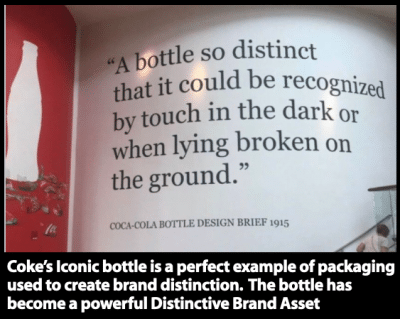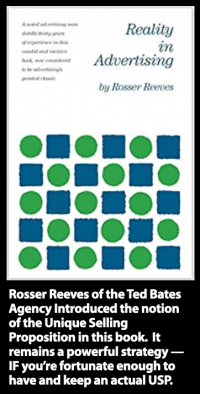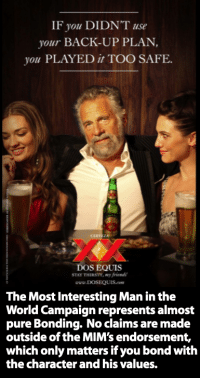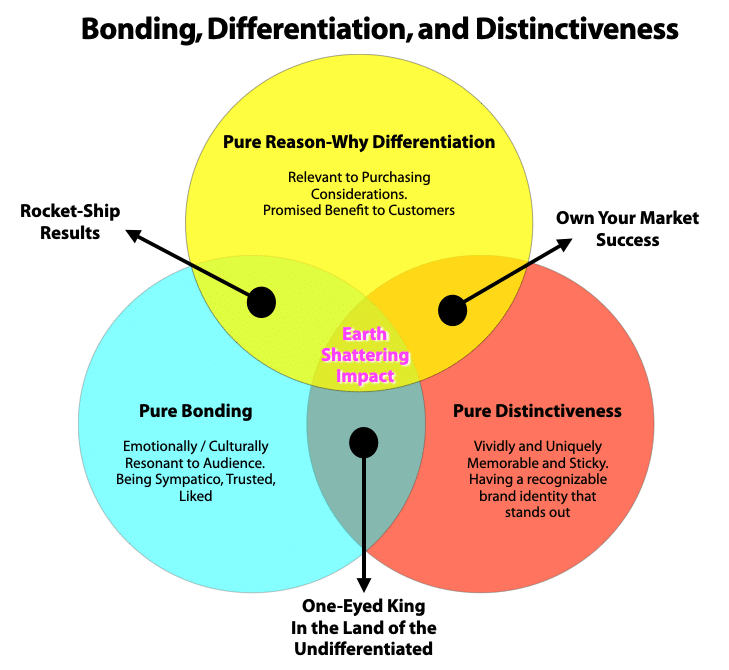
The goals of branding are two-fold:
- To preferentially attract more customers, in order to gain marketshare, and
- To be able to charge more than competitors while still winning the sale
In a word, branding aims at de-commodification: getting the customer to see you as the better, worthier option.
And there are three ways of pursuing this goal, with each method strengthening the other two:
1. You can make your brand stand out as Distinctive (and familiar)
 The goal is to make your brand stand out as familiarly distinctive within a field of seemingly generic alternatives.
The goal is to make your brand stand out as familiarly distinctive within a field of seemingly generic alternatives.
Your brand logo, colors, fonts, mascots, packaging, and colors are all visual elements aimed at distinctiveness.
Similarly, earworm-y sonic signatures, music, thematic elements to your ads, and brandable chunks also contribute to distinctiveness, though most chunks will provide differentiation as well.
Note that pure distinctiveness makes no claims to being better, nor to any other quality involve in “positioning” or differentiating.
More importantly, distinctiveness only works via physical and mental availability — people need to encounter your visual and audible brand cues either in person or via mass media.
If you have no share of mind, all your efforts at brand distinctiveness will be for naught.
Most importantly, distinctiveness works best when your distinctive brand identity is associated with something more than just your product or service.
2. You can Differentiate by Associating Your Brand with Positive Qualities or Performance Elements
 This is the realm of the classic “Unique Selling Proposition.”
This is the realm of the classic “Unique Selling Proposition.”
If you are able to claim a relevant product or service advantage over your competition, you can feature that in your ads and associate it with your brand.
And while it’s better if this advantage is unique, it’s not necessary.
While Visine “gets the red out,” it’s certainly not the only eye drop to do that. It’s just the one most associated with that benefit, thanks to their branding campaign.
In fact, creatively and preemptively claiming an otherwise non-unique benefit is what a Positively Good branding strategy is all about.
Ronseal’s immortal slogan “It does exactly what it says on the tin” remains a perfect example of this strategy, equaled only by H&K’s slogan “In a world of compromise, some don’t.”
Differentiation tends to be built on top of Distinctiveness, but it helps to be highly intentional about baking both elements into your branding campaign.
3. You Can Bond with Your Customers Over Values and Tribal Markers
Differentiation focuses on factors relevant to the performance of your product or service.

Differentiation tends to focus on “reason-why” style persuasion, even if the reason-why is “you can know what to expect.”
Bonding, on the other hand, means bonding over values and human connection that has no directly relevant connection to the performance or benefits to your product or service.
If people buy from you strictly because you’re the “home-town” brand, that’s bonding.
If they buy from you because they feel like they know and like you, the owner, whereas they have no connection to the other brands, that’s bonding.
Quintessential bonding campaigns almost always feature an owner or spokesperson, as exemplified by Columbia’s Tough Mother campaign, Hal Riney’s campaign for Bartles & Jaymes wine coolers, and Dos Equis’ Most Interesting Man campaign.
And like differentiation, bonding works best when built with (or on top of) distinctiveness.
Two Out of Three Is a Winner. Three Out of Three is a World Beater

In most markets and industries, two out of three branding pathways are enough to make you the dominant brand.
And if you manage to hit the trifecta, you can take over the world.
But while it’s possible to create a campaign that maximizes all three branding pathways “by accident,” it normally only happens when your advertising strategist consciously and intentionally bakes them into your ads.
If you’re finding your branding strategy is coming up short in these areas, it might be time to hire a better ad team.
P.S. Wanna see an example of how these factors played out in the energy drink market? Read all about it in my comparison of Jolt Cola to Red Bull. You can also learn how this dynamic played out in Beer Advertising
- Getting a Foot in the Door — Of Perception - November 27, 2025
- What Digital Superstars Know About Offline Advertising - November 17, 2025
- Unmistakable: A Tale of Two Boots and Branding Done Right - November 8, 2025
